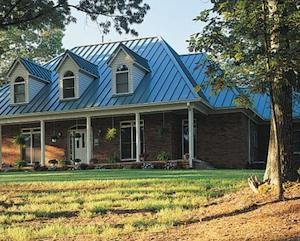Metal Roofing Materials
Building a green home requires attention to every product and material that goes into constructing it, and nowhere is that more important than choosing the right roofing material. The roof of a home has to be able to stand up to harsh conditions all day and all night; the sun's damaging UV rays, rain, wind, snow, and extreme heat and cold; the roof of a green home has to do this as well as have a minimal impact on the earth's resources.
Traditional asphalt shingles are by far the most common type of roofing material for new and replacement roofs, but they are far from being the most earth-friendly. They are made with toxic adhesives and non-renewable fossil fuels, typically last only around 15 to 20 years, and are very hard to recycle at the end of their life span. All of this requires a great deal of energy to produce new shingles, and a great deal of landfill space when their time is up.
According to the National Association of Homebuilders Research Center, 20 billion pounds of asphalt shingles are sent to U.S. landfills each year. If you put all those shingles into tractor trailers and lined them up end to end, the line would stretch from New York to Los Angeles, back to New York, then back to Chicago. Needless to say, that's a tremendous amount of waste.

Metal Roofing Materials - Petersen Aluminum
For all of these reasons, we recommend seeking out a roofing alternative to asphalt shingles that is more durable, and better for the health of the planet.
Metal Roofing Materials
Luckily, there are many roofing options available to choose from. One such choice is metal roofing. Available in a wide variety of colors and styles, a metal roof can make your roof an attractive addition to a sustainability built home.
The Environmental Benefits of Metal Roofing Materials
There are several factors that make a metal roofing materials a better choice than asphalt shingles:
- Installed properly, a metal roof is highly durable. Metal roofs have a much longer life span than shingles, with some having warranties of 50 years or more!
- When it is time to replace a metal roof, it is readily recyclable. This reduces landfill waste, and reduces the need for raw materials for new products.
- Many metal roofs are manufactured with recycled steel content, usually around 50% or more, which again helps to keep valuable materials out of landfills, and reduces the amount of energy required for manufacturing.
- A foil-faced radiant barrier insulation can easily be installed under a metal roof, providing even more energy and money savings relatively cheaply.
- Metal roofs are preferred for rainwater catchment systems, as water runs directly off without picking up any toxic contaminants or substances associated with asphalt shingles and other types of roofing materials.
Other Benefits of Metal Roofing Materials
In addition to several environmental advantages, metal roofing has some other positive features that make them attractive:
- In northern climates, snow and ice will more easily slide off a metal roof, preventing damage associated with ice dams and snow and ice buildup, which can cause structural damage to the roof, as well as leaking.
- Today's metal roofing is very attractive. It can be made to look like other regular roofing materials, from asphalt shingles to cedar shakes to slate or clay tiles. Metal roofing is also available in a wide variety of colors.
- Metal roofing is relatively lightweight, between 1 to 3 pounds per square foot. Comparatively, asphalt shingles weigh from 2 to 3.5 pounds per sq. ft., up to clay or concrete tiles which weigh in at 5.5 to 10 pounds per sq. ft. The lightness of a metal roof makes it compatible with a wide variety of roofing styles and slope angles.
Further Considerations for Metal Roofing Materials
Cost: Metal roofing is considered a premium roofing material, and as such carries a higher up-front price tag than a traditional asphalt roof. Metal roofs are, however, typically less expensive than cedar shake or tile roofing. The thing to remember is, even though the cost is higher up front, the savings over the long term are substantial; a metal roof will last 30,40,50, even 60 or more years, will help to reduce energy bills, and will add resale value to your home.
Noise: Many people think that a metal roof is going to be noisy in rain or other bad weather. In a residential structure, metal roofing is typically installed over a solid substrate with attic space and insulation between the roof and the living areas. Metal roofing is not going to be any noisier than another type of roof.
Lightning!: 'Will my house be struck by lightning more with a metal roof?' is a common question asked about metal roofs. While a home covered with a roof of metal might seem like a giant lightning magnet, in reality this is not the case. Lightning is attracted to the highest point of a structure regardless of what it's made of. A metal roof is not any more likely to be hit by lightning than any other kind of roof. In fact, in the event of a lightning strike, a metal roof can help prevent a house fire by dissipating the electrical charge over a large area. Metal is also completely noncombustible. Whew!
As the green homeowner, only you can make the final choice of roofing material. There are many factors that will affect your decision in addition to environmental impacts, total cost and appearance chief among them. Metal roofs are an attractive option that deserve a closer look.
comments powered by Disqus

























































































































































































